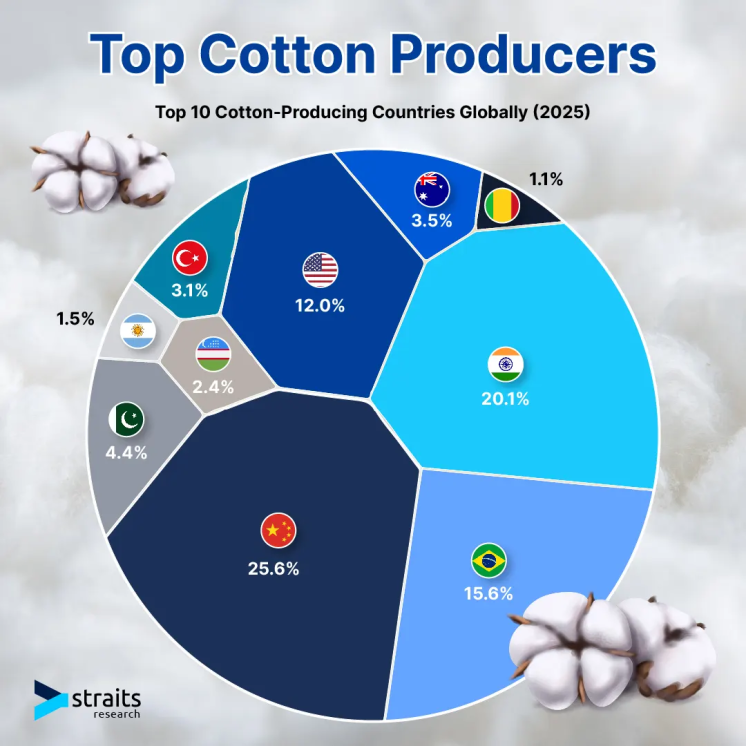Top 10 Cotton-Producing Countries Globally (2025)

Cotton continues to be one of the most important agricultural products in the world, contributing to the social and economic prosperity of millions of people, particularly in rural areas. Cotton is an essential raw material for the textile industry and has a big impact on the broader economic structure of both established and developing nations, as well as the creation of jobs and income stability.
Global Production Overview
Global cotton production is predicted to reach 116.99 million 480-pound bales in the 2025-2026 season, which is 2.5% less than the previous year but still 1.6 million bales more than the five-year average. Unfavourable weather patterns and shifting crop choices in some areas are primarily responsible for this modest decline. The top ten cotton-producing nations still control the majority of the world's supply chain as of June 2025. China leads with 25.6% of global output (30 million bales), with 87% of its cotton originating from the Xinjiang province.
India follows with 23.5 million bales (20.1%), primarily from Gujarat (27%), Maharashtra (21%), and Telangana (17%). Brazil ranks third, contributing 15.6% (18.25 million bales), with production concentrated in Mato Grosso (73%) and Bahia (20%). The United States holds a 12% share (14 million bales), mainly from Texas (30%), Georgia (16%), and Arkansas (9%). Other notable producers include Pakistan (4.4%), Australia (3.5%), Turkey (3.1%), Uzbekistan (2.4%), Argentina (1.5%), and Mali (1.1%).
The harvested cotton area varies notably among leading producers. India leads with 11.2-11.4 million hectares, although this is slightly declining as farmers shift toward pulses and oilseeds. The U.S. is expected to harvest 3.32 million hectares (8.2 million acres), factoring in weather-related abandonment. China's cotton area stands at 2.9 million hectares, with about 73% under full or partial irrigation. Brazil has seen an 8% year-on-year increase, reaching 2.1 million hectares, while Australia's harvested area is forecast at 460,000 hectares, supported by strong irrigation systems and export demand.
Furthermore, rainfall patterns play a crucial role in determining cotton yield and quality across major producing regions. In China, areas like the Yangtze Valley receive over 1,000 mm of annual rainfall, with about 85% falling during the cotton-growing season. India experiences 500-1,500 mm of rainfall, primarily concentrated during the monsoon. Brazil's key cotton-producing regions, such as Mato Grosso, receive between 1,400 and 2,300 mm annually, supporting effective rain-fed cultivation. The U.S. Cotton Belt typically gets 500-1,000 mm of rainfall, accompanied by hot summers with temperatures often exceeding 35°C (95°F). In Australia, cotton-growing regions exhibit a wide range of rainfall, from 350 mm to over 1,200 mm annually, depending on location.
Exports and Imports
As of June 2025, global cotton exports are projected to reach 44.79 million bales, with Brazil leading the way at 32% (14.3 million bales). The United States exports 12.5 million bales (28%), while Australia contributes 5 million bales (11%). West African nations like Mali and Benin each contribute 3% to exports. Other exporters include India, Turkey, and Greece (2% each), with Côte d'Ivoire and Argentina rounding out the top ten.
On the import side, Bangladesh is the top cotton importer in 2025, bringing in 8.4 million bales (19% of global imports). Vietnam follows with 8 million bales (18%), then China (6.5 million bales), Pakistan (5.3 million bales), and Turkey (4.8 million bales). Interestingly, India, despite being a major producer, is also projected to import 3 million bales. Other notable importers include Indonesia (2 million bales), Egypt (1.1 million), Malaysia (800,000), and Mexico (600,000).
Additionally, there are notable differences in the domestic consumption and export orientation of cotton among nations. While India maintains a balanced strategy between domestic usage and exports, China primarily consumes its cotton domestically to support its sizable textile sector. Brazil, on the other hand, is primarily focused on exports, with almost 80% of its cotton produced going to foreign markets.
Cotton continues to be essential to both rural livelihoods and international agricultural trade. Understanding the top-producing, exporting, and importing nations becomes essential for stakeholders throughout the textile supply chain as climate change, regional demands, and export-import patterns continue to change.




